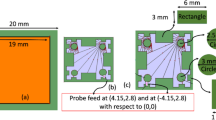Abstract
This paper proposes a new discrete wavelet transform (DWT)-based joint antenna selection scheme for spatially correlated multiple-input multiple output (MIMO) channels. To reduce the severe performance degradation of the traditional antenna selection schemes in correlated channels, a new scheme which employ joint antenna selection (JAS) at both link ends algorithm and embed DWT operations in the receiver-end RF chains is proposed. Through extensive simulations it is demonstrated that the proposed DWT-based joint antenna selection has significant improvement of the capacity for both i.i.d and correlated MIMO channels, while requiring only a minor hardware overhead and low computational complexity for the DWT operations. Moreover, it is shown that the capacity associated with DWT-based JAS is higher than the system employing DWT-based receive antenna selection (RAS) only. This is achieved in i.i.d. and correlated MIMO channels.
Similar content being viewed by others
References
Foschini G.J. and Gans M.J. (1998). On limits of wireless communications in a fading environment when using multiple antennas. Wireless Personal. Comm. 3: 311–335
Telatar I.E. (1999). Capacity of multi-antenna gaussian channels. Euro. Trans. Telecommun 10(6): 585–595
Molisch A.F. and Win M.Z. (2004). MIMO Systems with antenna selection. IEEE Microwave Magazine 5(1): 46–56
Sanayei S. and Nosratinia A. (2004). Antenna Selection in MIMO Systems. IEEE Commun. Mag. 42(10): 68–73
Molisch, A.F., Win, M.Z., Winters, J.H.: Capacity of MIMO Systems with Antenna Selection. In: Proc. IEEE Int. Conf. on Commun. (ICC’01), pp. 570–574, Helsinki (2001)
Gorokhov, A.: Antenna Selection Algorithms for MEA Transmission Systems. In: Proc. IEEE ICASSP, pp. 2857–2860, Orlando, May (2002)
Gorokhov A., Gore D.A. and Paulraj A.J. (2003). Receive Antenna Selection for Spatial Multiplexing: Theory and Algorithms. IEEE Trans. Signal Proc. 51: 2796–2807
Gharavi-Alkhansari M. and Gershman A.B. (2004). Fast Antenna Subset Selection in MIMO Systems. IEEE Trans. on Signal Proc. 52(2): 339–347
Chen, J., Yu, X.: Fast Receive Antenna Selection for MIMO Systems. In: Proc. the 38th Asilomar Conf.on Signals, Systems and Computers, vol. 2, pp. 1777–1780 (2004)
Dai L., Sfar S. and Khaled B. Letaief (2004). Receive Antenna Selection for MIMO Systems in Correlated Channels. IEEE Int’l Conf. on Commun. (ICC’04) 27(1): 2944–2948
Molisch A.F., Win M.Z., Choi Yang-Seok and Winters J.H. (2005). Capacity of MIMO Systems with Antenna Selection. IEEE Tran. Wireless Commun. 4(4): 1759–1772
As-Saafani, M.I., Sadi, S., Badran, E.F., Mohammed, D.A., Shaaban, S.: Antenna Selection Algorithms in Correlated Fading MIMO Channels. In: Proc. of the 23rd NRSC’06, Egypt, pp. B10(1–8), March (2006)
As-Saafani M.I., Badran E.F., Mohamed D.A. and Shaaban S. (2007). DWT-Based Antenna Selection for Correlated MIMO Channels. Int. J. Electr. Circ. Syst. 1: 54–59
Molisch, A.F., Zhange, X., Kung, S.Y., Zhang, J.: DFT-based Hybrid Antenna Selection Schemes for spatially correlated MIMO channels. IEEE Commun. Lett. October (2003)
Molisch, A.F., Zhange, X.: FFT-based Hybrid Antenna Selection Schemes for spatially correlated MIMO channels. IEEE Commun. Lett., 8(1) (2004)
Lifang Li, Jindal N. and Goldsmith A. (2005). Outage capacities and optimal power allocation for fading multiple-access channels. IEEE Trans. Inf. Theory 51: 1326–1347
Gesbert D., Bolecskei H., Gore D.A. and Paulraj A.J. (2002). Outdoor MIMO Wireless Channel: Models and Performance Prediction. IEEE Trans. Commun. 50(12): 1926–1934
Asztely, D.: Antenna Arrays in Mobile Communication Systems: Fast Fading and GSM Base Station Receiver Algorithms. Royal Inst. of Technology, Stockholm, Sweden, Tech. Rep. IR-S3-SB-9611, Mar. (1996)
Gorokhov, A., Collados, M., Gore, D., Paulraj, A.: Transmit/receive MIMO Antenna Subset Selection. IEEE Int. Conf. on Acoustics, Speech, and Signal Processing (ICASSP ’04), vol. 2, Montreal, May (2004)
Sanayei S. and Nosratinia A. (2007). Antenna Selection in Keyhole Channels. IEEE Trans. Commun. 55(3): 404–408
Foschini, G.J.: Layered Space-time Architecture for Wireless Communication in a Fading Environment when Using Multielement Antennas. Bell Labs Tech. J., pp. 41–59, Autumn (1996)
Alamouti S. (1998). A simple transmit diversity technique for wireless communications. IEEE J. Sel. Aera Commun. 16(8): 1451–1458
Schniter, P.: Finite-Length Sequences and the DWT Matrix. Connexions Web site. http://cnx.org/content/m10459/2.6/ (2005)
Mallat, S.: A Theory for Multiresolution Signal Decomposition: The Wavelet Representation. IEEE Trans. Pattern Analy. Mach. Intell. 11(7) July 89
Wornell, G.: Signal Processing with Fractals: A Wavelet Based Approach. Prentice Hall, Englewood Cliffs
Author information
Authors and Affiliations
Corresponding author
Rights and permissions
About this article
Cite this article
Badran, E.F. DWT-based joint antenna selection for correlated MIMO channels. SIViP 3, 35–45 (2009). https://doi.org/10.1007/s11760-008-0057-4
Received:
Revised:
Accepted:
Published:
Issue Date:
DOI: https://doi.org/10.1007/s11760-008-0057-4




